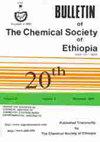Synthesis, characterization and theoretical aspects of copper and zinc divalent ion complexes with azo dye derived from 4,5-diphenylimidazole
IF 1.3
4区 化学
Q3 CHEMISTRY, MULTIDISCIPLINARY
引用次数: 0
Abstract
Azo dye ligand derived from 4,5-diphenyl imidazole and 4,4-diaminodiphenylmethane was synthesized by diazomium coupling reaction. In this reaction an amine (4,4-diaminodiphenylmethane was converted to the diazonium salt and coupled with 4,5-diphenyl imidazole. The bright coloured Cu(II) and Zn(II) complexes with this ligand were synthesized by refluxing the latest with both metals chloride salts. The prepared compounds were characterized by 1H-NMR, 13C-NMR, FTIR, UV-Visible, molar conductivity and atomic absorption. By the infrared data, the coordination between copper and zinc ions and the azo ligand achieved through the nitrogen of the azo group and one of the nitrogen atoms in the imidazole ring. By the molar conductivity test, the non- electrolytic nature of both complexes was also confirmed. The suggested structure for these complexes is octahedral. Using density functional theory (DFT) some theoretical data was obtained for the synthesized complexes. The obtained data include the highest occupied and the lowest unoccupied molecular orbitals energy (HOMO and LUMO), electron density, thermodynamic functions (ΔG°, ΔS°, ΔH°, ΔE°), ionization potential (IP), electron affinity (EA), electrophilicity(ὠ), electronegativity (En), chemical hardness (η) and dipole moment (μ). According to these studied parameters some properties of the two complexes were explained and discussed. KEY WORDS: Cu(II) and Zn(II) complexes, Azo ligand, 4,5-Diphenylimidazole, 4,4-Diaminodiphenylmethane, Theoretical study Bull. Chem. Soc. Ethiop. 2024, 38(2), 313-323. DOI: https://dx.doi.org/10.4314/bcse.v38i2.4铜和锌二价离子与 4,5-二苯基咪唑衍生偶氮染料配合物的合成、表征和理论研究
重氮鎓偶联反应合成了由 4,5-二苯基咪唑和 4,4-二氨基二苯甲烷衍生的偶氮染料配体。在该反应中,胺(4,4-二氨基二苯甲烷)被转化为重氮盐,并与 4,5-二苯基咪唑偶联。通过将最新的配体与这两种金属的氯化盐回流,合成了具有这种配体的亮色铜(II)和锌(II)配合物。制备的化合物通过 1H-NMR、13C-NMR、傅立叶变换红外光谱、紫外-可见光谱、摩尔电导率和原子吸收进行了表征。红外数据表明,铜离子和锌离子与偶氮配体之间的配位是通过偶氮基团的氮原子和咪唑环中的一个氮原子实现的。摩尔电导测试也证实了这两种配合物的非电解性质。这些复合物的结构为八面体结构。利用密度泛函理论(DFT)获得了合成复合物的一些理论数据。获得的数据包括最高占有和最低未占有分子轨道能量(HOMO 和 LUMO)、电子密度、热力学函数(ΔG°、ΔS°、ΔH°、ΔE°)、电离势(IP)、电子亲和力(EA)、亲电性(ὠ)、电负性(En)、化学硬度(η)和偶极矩(μ)。根据这些研究参数解释并讨论了这两种配合物的一些性质。关键词:铜(II)和锌(II)配合物,偶氮配体,4,5-二苯基咪唑,4,4-二氨基二苯基甲烷,理论研究 Bull.Chem.Soc.2024, 38(2), 313-323. DOI: https://dx.doi.org/10.4314/bcse.v38i2.4
本文章由计算机程序翻译,如有差异,请以英文原文为准。
求助全文
约1分钟内获得全文
求助全文
来源期刊
CiteScore
2.20
自引率
8.30%
发文量
113
审稿时长
6-12 weeks
期刊介绍:
The Bulletin of the Chemical Society of Ethiopia (BCSE) is a triannual publication of the Chemical Society of Ethiopia. The BCSE is an open access and peer reviewed journal. The BCSE invites contributions in any field of basic and applied chemistry.

 求助内容:
求助内容: 应助结果提醒方式:
应助结果提醒方式:


